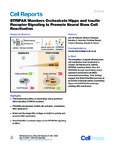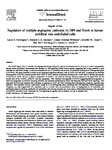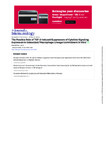STRIPAK Members Orchestrate Hippo and Insulin Receptor Signaling to Promote Neural Stem Cell Reactivation
| dc.contributor.author | Gil-Ranedo, J | |
| dc.contributor.author | Gonzaga, E | |
| dc.contributor.author | Jaworek, KJ | |
| dc.contributor.author | Berger, C | |
| dc.contributor.author | Bossing, Torsten | |
| dc.contributor.author | Barros, Claudia | |
| dc.date.accessioned | 2019-06-06T19:26:39Z | |
| dc.date.available | 2019-06-06T19:26:39Z | |
| dc.date.issued | 2019-06-04 | |
| dc.identifier.issn | 2211-1247 | |
| dc.identifier.issn | 2211-1247 | |
| dc.identifier.uri | http://hdl.handle.net/10026.1/14267 | |
| dc.description.abstract |
Adult stem cells reactivate from quiescence to maintain tissue homeostasis and in response to injury. How the underlying regulatory signals are integrated is largely unknown. Drosophila neural stem cells (NSCs) also leave quiescence to generate adult neurons and glia, a process that is dependent on Hippo signaling inhibition and activation of the insulin-like receptor (InR)/PI3K/Akt cascade. We performed a transcriptome analysis of individual quiescent and reactivating NSCs harvested directly from Drosophila brains and identified the conserved STRIPAK complex members mob4, cka, and PP2A (microtubule star, mts). We show that PP2A/Mts phosphatase, with its regulatory subunit Widerborst, maintains NSC quiescence, preventing premature activation of InR/PI3K/Akt signaling. Conversely, an increase in Mob4 and Cka levels promotes NSC reactivation. Mob4 and Cka are essential to recruit PP2A/Mts into a complex with Hippo kinase, resulting in Hippo pathway inhibition. We propose that Mob4/Cka/Mts functions as an intrinsic molecular switch coordinating Hippo and InR/PI3K/Akt pathways and enabling NSC reactivation. | |
| dc.format.extent | 2921-2933.e5 | |
| dc.format.medium | ||
| dc.language | en | |
| dc.language.iso | en | |
| dc.publisher | Elsevier (Cell Press) | |
| dc.subject | Hippo signaling | |
| dc.subject | InR/PI3K/Akt signaling | |
| dc.subject | STRIPAK members | |
| dc.subject | neural stem cells | |
| dc.subject | quiescence | |
| dc.subject | reactivation | |
| dc.subject | Adaptor Proteins, Signal Transducing | |
| dc.subject | Animals | |
| dc.subject | Animals, Genetically Modified | |
| dc.subject | Brain | |
| dc.subject | Cell Proliferation | |
| dc.subject | Cells, Cultured | |
| dc.subject | Drosophila Proteins | |
| dc.subject | Drosophila melanogaster | |
| dc.subject | Gene Expression Profiling | |
| dc.subject | Intracellular Signaling Peptides and Proteins | |
| dc.subject | Mitosis | |
| dc.subject | Nerve Tissue Proteins | |
| dc.subject | Neural Stem Cells | |
| dc.subject | Phosphatidylinositol 3-Kinases | |
| dc.subject | Protein Phosphatase 2 | |
| dc.subject | Protein Serine-Threonine Kinases | |
| dc.subject | Proto-Oncogene Proteins c-akt | |
| dc.subject | Receptor, Insulin | |
| dc.subject | Single-Cell Analysis | |
| dc.subject | Transcriptome | |
| dc.title | STRIPAK Members Orchestrate Hippo and Insulin Receptor Signaling to Promote Neural Stem Cell Reactivation | |
| dc.type | journal-article | |
| dc.type | Journal Article | |
| dc.type | Research Support, Non-U.S. Gov't | |
| plymouth.author-url | https://www.webofscience.com/api/gateway?GWVersion=2&SrcApp=PARTNER_APP&SrcAuth=LinksAMR&KeyUT=WOS:000470098200012&DestLinkType=FullRecord&DestApp=ALL_WOS&UsrCustomerID=11bb513d99f797142bcfeffcc58ea008 | |
| plymouth.issue | 10 | |
| plymouth.volume | 27 | |
| plymouth.publication-status | Published | |
| plymouth.journal | Cell Reports | |
| dc.identifier.doi | 10.1016/j.celrep.2019.05.023 | |
| plymouth.organisational-group | /Plymouth | |
| plymouth.organisational-group | /Plymouth/Faculty of Health | |
| plymouth.organisational-group | /Plymouth/Faculty of Health/Peninsula Medical School | |
| plymouth.organisational-group | /Plymouth/REF 2021 Researchers by UoA | |
| plymouth.organisational-group | /Plymouth/REF 2021 Researchers by UoA/UoA01 Clinical Medicine | |
| plymouth.organisational-group | /Plymouth/REF 2021 Researchers by UoA/UoA03 Allied Health Professions, Dentistry, Nursing and Pharmacy | |
| plymouth.organisational-group | /Plymouth/Research Groups | |
| plymouth.organisational-group | /Plymouth/Research Groups/Institute of Translational and Stratified Medicine (ITSMED) | |
| plymouth.organisational-group | /Plymouth/Research Groups/Institute of Translational and Stratified Medicine (ITSMED)/CBR | |
| plymouth.organisational-group | /Plymouth/Users by role | |
| plymouth.organisational-group | /Plymouth/Users by role/Academics | |
| plymouth.organisational-group | /Plymouth/Users by role/Researchers in ResearchFish submission | |
| dc.publisher.place | United States | |
| dcterms.dateAccepted | 2019-05-03 | |
| dc.rights.embargodate | 2019-11-27 | |
| dc.identifier.eissn | 2211-1247 | |
| dc.rights.embargoperiod | Not known | |
| rioxxterms.versionofrecord | 10.1016/j.celrep.2019.05.023 | |
| rioxxterms.licenseref.uri | http://www.rioxx.net/licenses/all-rights-reserved | |
| rioxxterms.licenseref.startdate | 2019-06-04 | |
| rioxxterms.type | Journal Article/Review | |
| plymouth.funder | Decoding the molecular identity of neural stem cell types::BBSRC |





